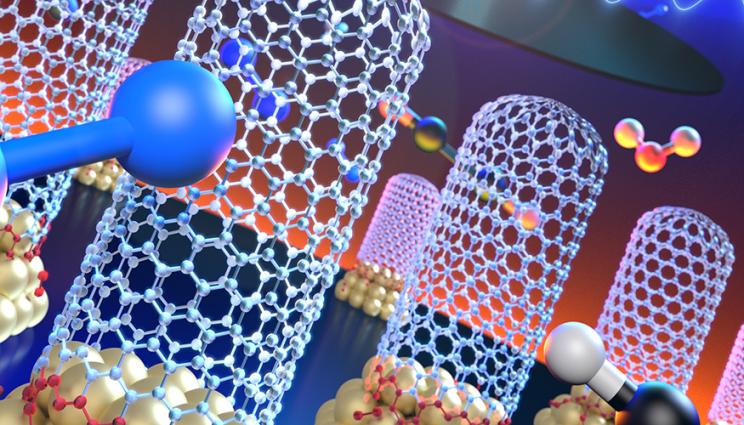| Oct 25, 2022 |
|
(Nanowerk News) Lawrence Livermore National Laboratory (LLNL) scientists are scaling up the production of vertically aligned single-walled carbon nanotubes (SWCNT) that could revolutionize diverse commercial products ranging from rechargeable batteries, automotive parts and sporting goods to boat hulls and water filters.
|
|
The research appears in the journal Carbon (“Synthesis of wafer-scale SWCNT forests with remarkably invariant structural properties in a bulk-diffusion-controlled kinetic regime”).
|
 |
| Vertically aligned carbon nanotubes growing from catalytic nanoparticles (gold color) on a silicon wafer on top of a heating stage (red glow). Diffusion of acetylene (black molecules) through the gas phase to the catalytic sites determines the growth rate in a cold-wall showerhead reactor. (Image: Adam Samuel Connell, LLNL)
|
|
Most CNT production today is used in bulk composite materials and thin films, which rely on unorganized CNT architectures. For many uses, organized CNT architectures such as vertically aligned forests provide important advantages for exploiting the properties of individual CNTs in macroscopic systems.
|
|
“Robust synthesis of vertically-aligned carbon nanotubes at large scale is required to accelerate deployment of numerous cutting-edge devices to emerging commercial applications,” said LLNL scientist and lead author Francesco Fornasiero. “To address this need, we demonstrated that the structural characteristics of single-walled CNTs produced at wafer scale in a growth regime dominated by bulk diffusion of the gaseous carbon precursor are remarkably invariant over a broad range of process conditions.”
|
|
The team found that the vertically oriented SWCNTs retained very high quality when increasing precursor concentration (the initial carbon) up to 30-fold, the catalyst substrate area from 1 cm2 to 180 cm2, growth pressure from 20 to 790 Mbar and gas flowrates up to 8-fold.
|
|
LLNL scientists derived a kinetics model that shows the growth kinetics can be accelerated by using a lighter bath gas to aid precursor diffusion, and that byproduct formation, which becomes progressively more important at higher growth pressure, could be greatly mitigated by using a hydrogen-free growth environment. The model also indicates that appropriate choice of the CNT growth recipe and fluid dynamics conditions can increase the production throughput by 6-fold and the carbon conversion efficiency to higher than 90%.
|
|
“These model projections, along with the remarkably conserved structure of the CNT forests over a wide range of synthesis conditions, suggest that a bulk-diffusion-limited growth regime may facilitate preservation of vertically aligned CNT-based device performance during scale up,” said LLNL scientist and first author Sei Jin Park.
|
|
The team concluded that operating in a growth regime that is quantitatively described by a simple CNT growth kinetics model can facilitate process optimization and lead to a more rapid deployment of cutting-edge vertically-aligned CNT applications.
|
|
Applications include lithium-ion batteries, thermal interfaces, water purification, supercapacitors, breathable fabrics and sensors.
|


